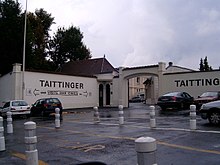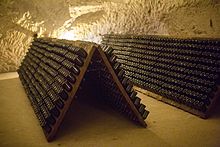Taittinger
This article needs additional citations for verification. (March 2013) |
49°14′39″N 4°02′46″E / 49.24429°N 4.04618°E

Taittinger (pronounced
Champagne production
Founded in 1734, the Taittinger
History


In 1734, Jacques Fourneaux established a wine-business in Champagne and worked closely with the Benedictine abbeys which, at that time, owned the finest vineyards in the region. After the First World War, the wine house was moved to a large mansion on the Rue de Tambour in which
The Taittingers were a family of wine merchants who, in 1870, moved to the Paris region from the
In 1932,
From 1945 to 1960 the business was run by Pierre's third son François. Under his direction, the Taittinger cellars were established in the Abbey of Saint-Nicaise, built in the thirteenth century in Gallo-Roman chalk pits dating from the fourth century. After François' death in an accident, his brother Claude took over and directed the business from 1960 to 2005. It was during this time that Taittinger became a champagne house of world renown.
Champagne Taittinger was sold in July 2005 by the Taittinger family,
Finally, on 31 May 2006, the Northeast Regional Bank of the Crédit Agricole, in collaboration with Pierre-Emmanuel Taittinger, bought the business for 660 million euros. The area covers 288.84 hectares of vineyards and has 12 to 13 million bottles in stock. The Château de la Marquetterie and its cellars were part of the overall purchase. The Starwood group retained some of the hotels, including luxury hotels Crillon, Lutetia and Martinez, and the hotel chains Campanile and Kyriad.
Claude Taittinger retired in 2006 and his nephew Pierre-Emmanuel Taittinger replaced him as head of the business.
In 2017, it was announced that Taittinger had become the first champagne house to plant vines in the UK.[8] Champagne Taittinger entered into a joint venture with UK wine agents Hatch Mansfield and in 2015 bought up land in Chilham, Kent, to plant 40 hectares of vines over the next three years.
In October 2019 it was announced that Vitalie Taittinger would become president from December 31, 2019. She had been working for the company for 12 years and was director of marketing and communications.
See also
References
- ^ Lascelles, Alice (2021-03-03). "Bursting the bubble – meet the female winemakers who popped the patriarchy". Financial Times. Retrieved 2024-03-05.
- ^ "Vitalie Taittinger takes over the presidency of the eponymous Champagne house". www.vitisphere.com (in French). Retrieved 2024-03-05.
- ^ "The Beginner's Guide to Visiting Champagne". Condé Nast Traveler. 2018-09-07. Retrieved 2024-03-05.
- ISBN 1-74048-050-3. p.167.
- ^ Smithers, Rebecca (2017-05-07). "French champagne house Taittinger plants first vines in English soil". The Guardian. Retrieved 2018-01-15.
- ISBN 978-2-84138-059-6
- ^ «The Taittinger family in the history of the Hotel Crillon»
- ^ "Taittinger Invests in English Sparkling Wine". Ikon London Magazine. 3 May 2017. Retrieved 2017-05-05.
